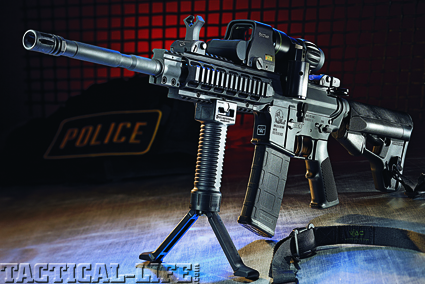The Armalite SPR Mod 1 LE, featuring a proprietary modular rail system, comes from the storied company that initially launched the AR platform.
ARMALITE is where it all started. While Colt is certainly the company that popularized the weapon platform we now know as the AR-15, ArmaLite, is where it began. In 1954, Eugene Stoner, chief engineer for ArmaLite, a division of Fairchild Engine & Airplane Corporation, designed a series of prototype small arms, including the AR-3, AR-9, AR-11, AR-12, none of which saw significant production. However, these design projects did help him towards the one real success that he had up to that point, the AR-7 survival rifle (a component .22 LR rifle that could fit into its stock and float), which was adopted by the United States Air Force.
In 1955, Stoner completed initial design work on the revolutionary AR-10, a lightweight, select-fire infantry rifle in 7.62x51mm NATO (.308) caliber. The AR-10 was submitted for rifle evaluation trials to the US Army’s Springfield Armory late in 1956. When compared with competing rifle designs previously submitted for evaluation, the AR-10 was smaller, easier to fire in automatic, and much lighter. However, it arrived late in the testing cycle and the Army rejected the AR-10 in favor of the more conventional T44, which would become the M14.
Advertisement — Continue Reading Below
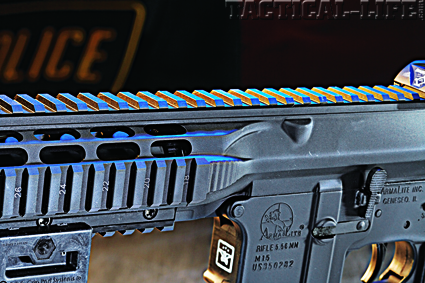
The SPR’s Continuous Optics Platform employs a one-piece upper receiver/forend system for stability.
At the request of the U.S. Military, Stoner and his staff designed the AR-15 from the basic AR-10 design, scaling it down to fire the smaller .223 cartridge. The rest is history as they say, as the AR-15 was later adopted by the U.S. Military as the M16 rifle. After ArmaLite sold the rights to the AR-15 to Colt, Stoner turned his attention to the AR-16 design, another advanced 7.62mm rifle but one that used a more conventional piston and a number of stamped parts to reduce cost. This weapon saw only prototype development but adaptation to .223 resulted in the somewhat successful and often imitated ArmaLite AR-18.
Advertisement — Continue Reading Below
During the Vietnam Conflict, Colt developed a shorter version of the M16, what many called the “Colt Commando,” which led to the development of today’s M4. A semi-automatic 16-inch version of the M4 is very popular with police and legally armed citizens alike, and many manufacturers have developed guns to meet this demand. ArmaLite is no exception, and their new variation is certainly directed at the law enforcement community.
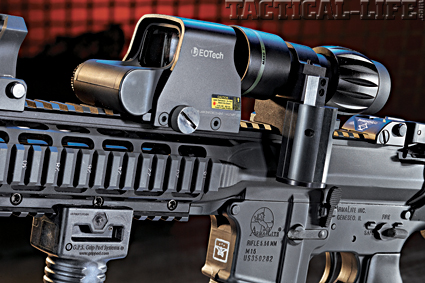
The Mako Group’s 3X Magnifier is a cost effective and worthwhile accessory on a law enforcement carbine, easily mounted and used in conjunction with this EOTech XPS sight.
Advertisement — Continue Reading Below
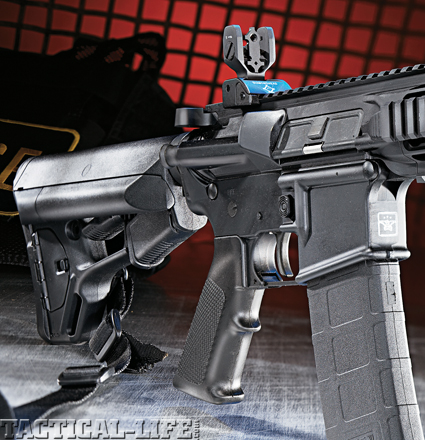
The Magpul ACS telescoping stock offers greater cheek surface area, and storage space for batteries.
The Special Purpose Rifle (SPR) Mod 1 LE is an ArmaLite innovation directed at the law enforcement community. I’m sure that many readers have wondered, “What is the difference between all of the various AR-15 rifles that are currently available and why such a wide price difference?” Admittedly, I have wondered this as well, and the answer is the quality of the components used, the care in production and the features the rifle/carbine possess. In the case of the SPR Mod 1 LE, it is the Continuous Optics Platform. This modification is not just a forward rail system, but an entire upper receiver which means there is no gap between the forward handguard and the upper receiver. This allows the shooter to place their chosen optic or magnifier unit anywhere they choose without having to “bridge” the normal gap.
Advertisement — Continue Reading Below
Additionally, the one piece construction’s strength and rigidity will keep your sights zeroed under the most extreme of conditions.
Chambered for 5.56x45mm NATO, other SPR Mod 1 LE features include a 16-inch double lapped, chrome-lined/chrome moly vanadium lined mil-spec barrel with a rate of twist of 1-in-7-inch to better stabilize the popular 69- to 77-grain bullets that are proving to be quite effective in actual shootings. The flash suppressor is standard military specifications while the front sight base/gas block allows the barrel to free-float while offering a Picatinny rail that is 0.293 of an inch lower than the upper receiver. The upper is a forged flattop design with Picatinny rail with laser engraved rail numbers for the consistent mounting of related accessories. The lower receiver is forged 7075-T6 aluminum for reduced weight and added strength. A military-grade collapsible M4-style stock is standard and while this stock is functional, it certainly isn’t optimal. Weight is approximately 6.5 pounds while overall length is 35.5 inches extended and 32 inches collapsed. Included in the package from the factory is one mil-spec 30-round magazine, sling, black carrying case and an owner’s manual.
It seems like new “add-ons” for the AR-15 platform are introduced everyday, but do not fall into the trap of thinking that gear will improve performance. Training and practice improves performance, but there are a few upgrades (versus add ons, if you get my drift) that are a good idea for most every AR. The first thing is a set of iron sights, and since the SPR Mod 1 LE came with a “slick top,” it gave me the opportunity to work with the new flip-up irons from Diamondhead Advanced Combat Solutions. Diamondhead is a Massachusetts based corporation that manufactures advanced combat sights for the M4/AR15 platform and any weapon using the Mil-Std-1913 rail system. Diamondhead products include the Diamondhead front and rear combat sight and the “Auto-Ranger” Combat Sight. The Diamondhead Lo-Pro Series offers a “soft-lock” flip-up front and rear sight with an extremely low folded profile of just 0.395 of an inch.
Advertisement — Continue Reading Below
Diamondhead sights incorporate the unique diamond-shaped apertures with the diamond-shaped front post shield or sight housing. The “diamond in a diamond” view makes for a fast on target sight acquisition in all levels of light beyond total darkness. This sight arrangement automatically places the front sight post in the middle of the rear aperture, eliminating all guesswork. Trust me, these are iron sights that you just have to try to truly understand.
The mil-spec telescoping stock was replaced with the new Magpul Adaptable Carbine/Storage (ACS). The ACS is a drop-in replacement that gives the operator extra storage options, a comfortable cheek weld and an advanced dual-locking lever. The streamlined exterior prevents snagging while removable battery storage compartments run the full-length of the extra-wide comb that hold two AA or three CR-123 batteries and has a rubber buttpad that holds the stock in place during rapid fire. I placed a Viking Tactics (VTAC) two-point sling on the SPR, which happens to be one of my favorites. This easy “push/pull” sling allows for easy tightening and release of sling pressure by merely pulling on the release strap. Simple and easy, which is how I like all of my combat gear to work.
Optics
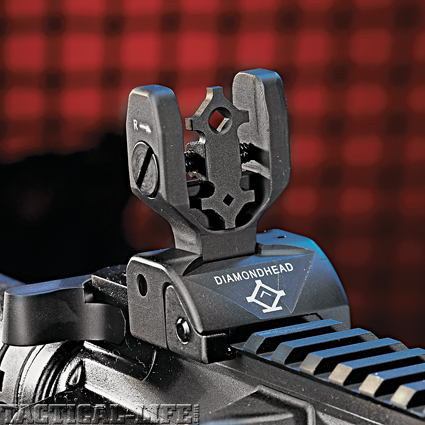
Advertisement — Continue Reading Below
The Diamondhead flip up sight provided for the article proved to be robust and simple to use. Merely place one diamond inside another and press the trigger.
Anytime you can simplify armed conflict you are well advised to do so and the use of red dot sights do this. Eliminating the eye sprint between front sight focus and trying to track the movements of your armed opponent is tough to do even under the best of circumstances. A red dot-style optic allows the end user to “supper-impose and press,” meaning the dot is placed on target and the shot is taken without added vision complications. I opted for the EOTech XPS “mini” holographic sight due to its small size and use of limited rail space. The EOTech has a large optical window with a very easy to see circle/dot reticle that allows the shooter to use the red dot for precise shots and the circle for CQB applications. However, optics require one level of magnification for every 100 yards/meters that they are likely to be used in, and while the EOTech will offer a good sighting system out beyond this, it is nice to have some level of magnification if nothing more than to see what that object is the suspect’s hand!
Many of the optics companies offer magnified optics or magnifier units that work with the red dot to increase their capability. Unfortunately, these units are quite expensive and at some point, most working cops with families will just say “enough!” The truth is, cops do not always need mil-spec gear and sometimes lesser-cost options can also be good options, such is the case with the Mako Group 3x magnifier. The Mako 3x is an affordable magnifier that works with EOTech, Aimpoint, and other red dot or holographic sights. The unit allows the end user to quickly switch from CQB to long-range use without losing sight of your adversary. It mounts directly behind your chosen red dot sight with the included 30mm quick detach mount, but I would suggest the MAM30. The unit doubles as a handheld monocular when not needed on the gun. A multi-coated lens, 30mm diameter allows for maximum light to be transferred. Eye relief is 1.65 inches, while the unit’s length is 5 inches. It weighs in at a very reasonable 6.4 ounces, and is water and shock proof. It works with most EOTech models as well as the Aimpoint Comp series and similar sights.
Advertisement — Continue Reading Below
The MAM30 mount I mentioned is Mako’s simple solution to a serious problem. Many operators felt that what was lacking in their current red-dot optics setup was a way to rapidly clear the magnifier from the path of their scope in a way that doesn’t change the balance of the weapon. Not only did they want a way to clear it, they wanted to be able to keep it in a disengaged position without it riding awkwardly on the firearm where it makes the profile of the weapon larger and causes the optic to smack into walls and other obstacles and not have to remove or replace the optic every time they need to change engagement distances. The MAM30 is Mako’s solution to this problem, as merely pushing a button about the size of a magazine release on a pistol will lift the magnifier out of the way. To bring it back down, merely push down and it locks in place automatically.
Shooting Impressions
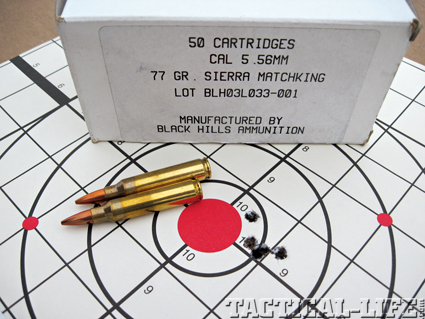
Bullet weight measured in grains, velocity in feet per second (fps) by Shooting Chrony, and accuracy in inches for 5-shot groups from 100 yards.
Advertisement — Continue Reading Below
While the ArmaLite SPR Mod 1 LE certainly looked good from the box and was certainly now “dressed for success,” a gun that will not run is no fun, so it was time to put the gun through its paces. I started the test with the conventional accuracy standard of 100 yards, to see how it would group. Most 16-inch AR platforms will shoot around 2.5 inches at 100 yards and this is certainly fine accuracy for a combat carbine. However, the tighter the group, the better as long as the gun is reliable, and since this gun offers a 1-in-7-inch rate of twist, it would be a waste not to test it with the heavier bullets.
While it is all well and good to talk about “minute of angle” this is not what a battle rifle/carbine is all about. Being able to hit a chest-size target within the distances of one’s operational parameters is, thus, all of these groups are very acceptable and one should be more concerned with their on target effectiveness. Still, it is nice to see that the SPR Mod 1 LE is capable of such tight groups.
The remainder of the range session consisted of working with the SPR Mod 1 LE through a series of drills designed to enhance one’s combative skills such as “snap” shooting from ready, pistol transition drills, pivots, turns, going to kneel and prone, shooting while moving and multiple targets. I do not like to hit the range and not do something that will help build skills, so in recent years my gun tests have become practice sessions and this one was no different. I will be the first to admit that the limited practice time I do have is dedicated to pistol work (the gun I am more likely to be carrying), so the carbine gets put on the back burner. Thus, when I can “work out” with any carbine, I do so. The ArmaLite ran without a hiccup, with the only stoppages being the ones that I intentionally induced by inserting a dummy round. The gun has a nice feel and the solid rail system/upper receiver is a definite plus. The ArmaLite SPR Mod 1 LE carbine is a solid, well-built carbine that brings the story of the AR-15 full circle. It is certainly worth your consideration.
